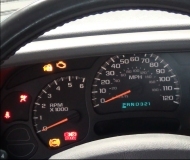There's two possibilities. A misfire will cause a rough running engine that will have a tendency to stall when it's idling, but not while you're driving. The second possibility is the engine is simply idling too slowly. You'll feel the individual power pulses from each cylinder. They will be very pronounced at slow speeds and can feel like a misfire. Those pulses occur so close together at normal idle speed that we can't feel them.
The first thing to consider is whether the battery was recently disconnected or run dead. If it was, the Engine Computer has to relearn "minimum throttle" before it will know when it has to be in control of idle speed. Until that relearn takes place, it is common for the idle speed to be so low that the engine stalls at stop signs. The clue is it will always stay running if you hold the gas pedal down about 1/8". To meet the conditions for the relearn to take place, drive at highway speed with the engine warmed up, then coast for at least seven seconds without touching the brake or gas pedals.
Your mechanic can also use a scanner to display live data from the Engine Computer. In particular, it will show the number of "steps" it has set the idle speed motor to. Out of 256 steps, number 32 is typical for a properly running engine. If it's at around step 50 or higher, suspect a misfire condition is causing slow engine speed and the computer is raising idle speed to compensate, or the air passage that idle speed motor controls is plugged with carbon. When it's plugged, the engine speed won't respond the way the computer expects it to. That passage commonly got plugged on the 3.0L engines in the minivans and some cars but it's pretty rare now because there are better additives in the fuel today. Also, I don't ever recall seeing a plugged passage on an Intrepid.
If the AIS (automatic idle speed) motor is being set to a step lower than around 30, the computer is trying to lower the idle speed. That is the typical response to a vacuum leak. The vacuum is created by the running engine and is what sucks in the fresh air and fuel. All of the air going into the engine passes either through the throttle blade that you control with the gas pedal, or through that idle air passage. The computer calculates the amount of air going in from the readings of other sensors, and by knowing the size of the engine and how fast it's running. A vacuum leak occurs when air finds another way to sneak in that the computer doesn't know about. That throws all of its calculations off. A vacuum leak results in the idle speed increasing, but the engine will have less power when it's under load because there isn't enough gas to go with that extra air. Vacuum leaks most commonly occur from a cracked or dry-rotted vacuum hose or from a leaking intake manifold gasket. The power brake booster, cruise control servo, and many emissions-related components run on that engine vacuum and they all have rubber hoses that can leak. Your mechanic will have tools for finding those leaks.
Lean and rich refers to the ratio of air and fuel. That has to be controlled and adjusted very precisely for complete burning of the fuel. That provides the most power, best fuel mileage, and lowest emissions. When there's a vacuum leak, or some other malfunction, typically with a sensor, extra air goes into the engine that the computer doesn't know about so it doesn't command enough gas to go with that air. Too much air with not enough fuel is a "lean" condition. You will feel that in the way the engine runs and responds to the gas pedal. Other things can cause too much fuel to go into the engine. That's a "rich" condition. There isn't enough air to go with all of the fuel so some fuel goes out the tail pipe unburned and wasted. That decreases fuel mileage and increases emissions. Unless it's quite bad, you often won't notice a rich condition in the way the engine runs.
The computer is constantly monitoring the exhaust gas while you drive to see if it's too lean or too rich. That's the basic version; it's actually more involved than that. You can get away with driving the car like that for a little while but more serious problems COULD develop later. In particular, a rich condition that is beyond the computer's ability to adjust it can lead to overheating the catalytic converter. Part of its job is to burn any unburned fuel that leaves the engine but too much fuel will make it overheat. That can melt the material inside it and cause it to become plugged. Replacement is the only remedy for that and it's expensive.
Gas will only burn as a vapor, not as a liquid. When a liquid vaporizes, it becomes cold, and that helps cool the pistons in the engine. If the engine runs lean for a long time, especially at high speeds, the aluminum pistons can start to melt. That's a real big concern with racing engines, ... Not so much for passenger car engines. You would notice a running problem long before damage occurred to the engine from a lean condition.
SPONSORED LINKS
Thursday, December 22nd, 2011 AT 10:49 AM




